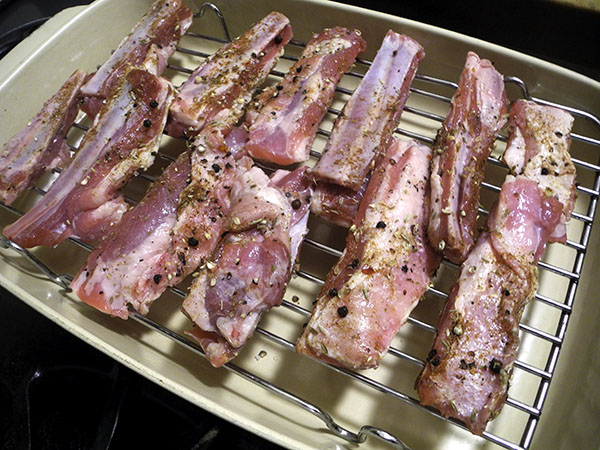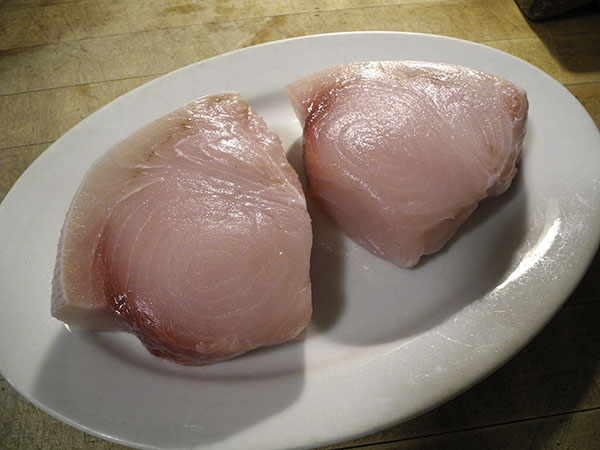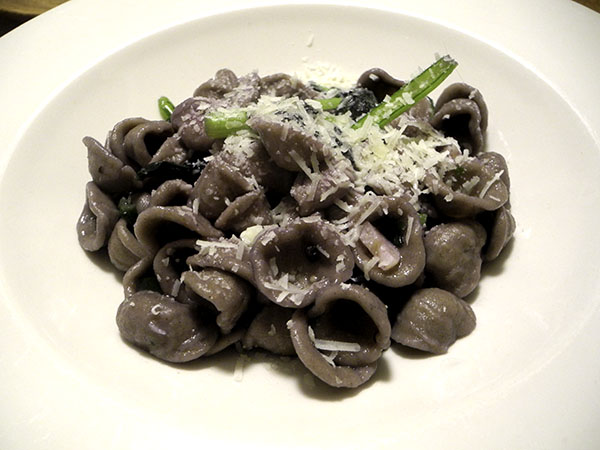
‘Goat wings’, I’m calling them.

They had started out great.
But then they spent too much time in the oven. My estimate of the cooking time for slow-braised goat ribs was far more generous than it should have been (I was looking at a recipe for lamb, but I had goat (goats are pretty small, even when compared to lamb) and and I was too busy elsewhere to check on how they were doing.
Adding to my discomfort, as someone who really hates finger food, was the fact that there was no way I was going to be able to eat these somewhat desiccated ribs with a knife and fork.
But still, they were delicious, and then even gilded.

I included a sauce, which began with my deglazing the oven pan, and which happened just after I snapped this image following the removal of the ribs, and the rack on which they had rested, and before adding some stock. It’s amazing how small an amount of concentrated drippings it takes to produce something really rich.

At least I think I got the vegetable accompaniment right: Ribs and rutabaga seem made for each other, and this root even came with its own greens!
- a little over a pound of goat ribs (or ‘riblets’), already-separated from each other, from Lynnhaven Dairy Goat Farm, seasoned all over with sea salt and freshly ground black pepper then rubbed all over with a mix of dried herbs and spices (a pinch of both habanada and smoked Jamaican Scotch bonnet pepper; roughly a quarter teaspoon each of smoked Spanish pikante paprika; freshly ground cumin, coriander seed, and fennel seed; and a smidgen of turbanado sugar), set on a rack inside a large enameled cast iron oven pan and bake in a 300º oven for 1 hour, the heat then increased to 375º and, theoretically, the ribs cooked until browned outside, tender within, and an instant-read thermometer registered 175º, or, according to the recipe I had grabbed just before beginning dinner, about 1 hour longer [I’ll probably look for another recipe next time, since I this one and I may now have assembled some bad karma], the goat set aside while preparing a sauce: once the fat had been poured out of the pan it was placed on a burner above a medium flame and a quarter of a cup of low-sodium chicken stock added and stirred, scraping up the browned bits [shown in the picture above], the liquid poured into a small saucepan and a little more stock added, the liquid cooked over medium heat until reduced by half, a teaspoon of grainy Dijon mustard and some salt and pepper added, finished, off heat, by whisking in a teaspoon or so of cold butter, served on the plates with a garnish of micro red mustard from Windfall Farms, the sauce transferred to small bowls with small spoons to enable the diners to decide how to use it (basically, I thought this arrangement would at least reduce the stickiness involved in consuming the ‘wings’
- a little less than a pound of rutabaga from Norwich Meadows Farm, washed, dried, peeled, and cut as for French fries, tossed with little more than one tablespoon of olive oil, some sea salt and freshly-ground black pepper, some now-dried rosemary leaves from Chelsea WHole Foods, and a bit of crushed dried pieces of golden/bronze habanada pepper, then spread evenly, hopefully without crowding, onto a large, seasoned, unglazed ceramic Pampered Chef oven pan and roasted at 400º for about 30 or 35 minutes, garnished with micro bronze fennel from Two Guys from Woodbridge
- the rutabaga greens that had been attached to the root (there weren’t many, but, as they were from a form of turnip, they were terrific), washed, drained, chopped roughly, and wilted inside a small antique copper pot in olive oil along with a single ‘music’ or ‘strong neck’ garlic clove from Windfall Farms which had been lightly-browned in the oil first
- the wine was a Portuguese (Bairrada) red, Beira ‘FP’ Baga, Filipa Pato 2017, from Astor Wines
- the music was Bruckner’s eighth Symphony, Pierre Boulez conducting the Vienna Philharmonic















